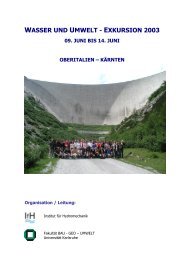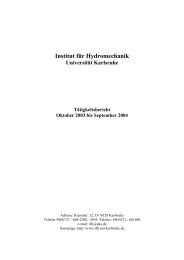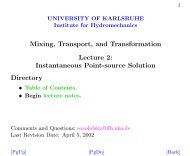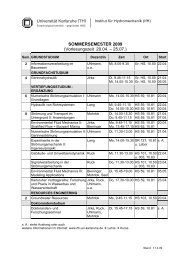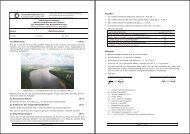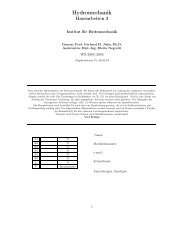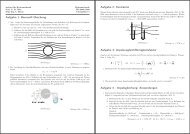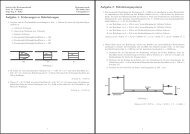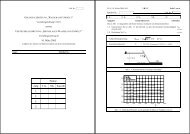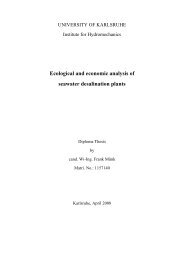user's manual for corhyd: an internal diffuser hydraulics model - IfH
user's manual for corhyd: an internal diffuser hydraulics model - IfH
user's manual for corhyd: an internal diffuser hydraulics model - IfH
Create successful ePaper yourself
Turn your PDF publications into a flip-book with our unique Google optimized e-Paper software.
A reasonably good discharge distribution along the <strong>diffuser</strong> (first bar-chart, Fig. 26) with<br />
maximum deviations from the me<strong>an</strong> discharge of not more th<strong>an</strong> 5 % of the me<strong>an</strong> discharge<br />
(second bar-chart, Fig. 26) is obtained. Due to different pressure losses along the <strong>diffuser</strong> pipe<br />
<strong>an</strong>d the port/riser configurations (line in second bar-chart, Fig. 26) the discharge is increasing<br />
here to the seaward end. Usually <strong>diffuser</strong> c<strong>an</strong>not be laid horizontally as assumed here, because<br />
of the sloping bathymetries. There<strong>for</strong>e <strong>an</strong>other calculation is shown in Fig. 26 on the right<br />
side, with a sloped <strong>diffuser</strong> with <strong>an</strong> assumed elevation difference of 3 m along the <strong>diffuser</strong><br />
length of 449 m (= 6.7 % 0 ). The discharge deviation in this case is almost neglectable, which<br />
is due to a higher pressure difference between the sewage in the <strong>diffuser</strong> pipe <strong>an</strong>d the heavier<br />
ambient water especially in deeper waters at the seaward <strong>diffuser</strong> end.<br />
The flow velocities in the <strong>diffuser</strong> pipe continuously decrease in seaward direction (fourth<br />
bar-chart, Fig. 26). For the last 25 port locations velocities below 0.5 m/s are predicted, which<br />
might cause sedimentation of particles in the <strong>diffuser</strong>. This number reduces <strong>for</strong> peak flows<br />
(Q = 12 m³/s), (Fig. 27), to about 16 but still the last 75 m of the <strong>diffuser</strong> have velocities much<br />
lower th<strong>an</strong> 0.5 m/s. That me<strong>an</strong>s, that even <strong>for</strong> maximum discharges scouring velocities are not<br />
obtained <strong>for</strong> the end part of the <strong>diffuser</strong>. Considering, that the present treatment is only coarse<br />
screening, this might cause problems <strong>for</strong> the <strong>diffuser</strong> end part.<br />
Fig. 26: Flow characteristics <strong>for</strong> design flow. Left: horizontal <strong>diffuser</strong>, right: sloped <strong>diffuser</strong> 3m/449m.<br />
Top-down: Individual riser flow distribution along <strong>diffuser</strong>, riser flow deviation from me<strong>an</strong>,<br />
losses in port/riser configurations (line), port <strong>an</strong>d jet discharge velocities <strong>an</strong>d <strong>diffuser</strong> pipe<br />
velocities, port <strong>an</strong>d <strong>diffuser</strong> diameter (lines)<br />
Institut für Hydromech<strong>an</strong>ik, Universität Karlsruhe 55



